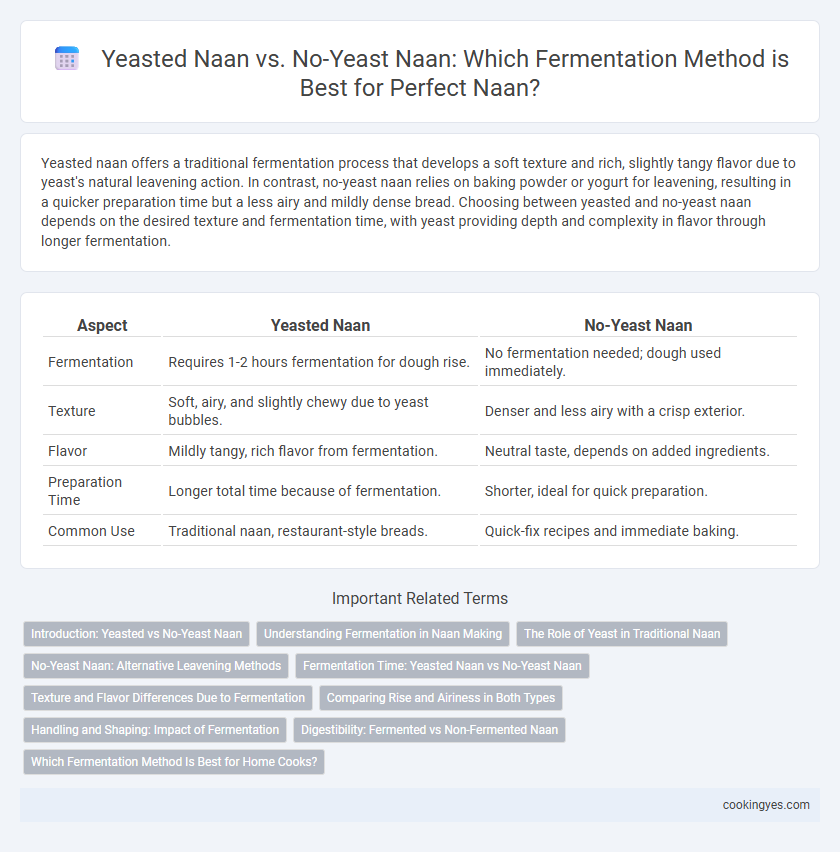Yeasted naan offers a traditional fermentation process that develops a soft texture and rich, slightly tangy flavor due to yeast's natural leavening action. In contrast, no-yeast naan relies on baking powder or yogurt for leavening, resulting in a quicker preparation time but a less airy and mildly dense bread. Choosing between yeasted and no-yeast naan depends on the desired texture and fermentation time, with yeast providing depth and complexity in flavor through longer fermentation.
Table of Comparison
| Aspect | Yeasted Naan | No-Yeast Naan |
|---|---|---|
| Fermentation | Requires 1-2 hours fermentation for dough rise. | No fermentation needed; dough used immediately. |
| Texture | Soft, airy, and slightly chewy due to yeast bubbles. | Denser and less airy with a crisp exterior. |
| Flavor | Mildly tangy, rich flavor from fermentation. | Neutral taste, depends on added ingredients. |
| Preparation Time | Longer total time because of fermentation. | Shorter, ideal for quick preparation. |
| Common Use | Traditional naan, restaurant-style breads. | Quick-fix recipes and immediate baking. |
Introduction: Yeasted vs No-Yeast Naan
Yeasted naan relies on yeast fermentation to create a soft, airy texture with characteristic bubbles and slight tang, enhancing flavor complexity. No-yeast naan uses alternative leavening agents like baking powder or yogurt, offering a quicker rise and denser crumb without the fermentation time yeast requires. The choice between yeasted and no-yeast naan impacts texture, taste, and preparation time, catering to different culinary preferences and time constraints.
Understanding Fermentation in Naan Making
Yeasted naan relies on baker's yeast to induce fermentation, producing carbon dioxide that creates a light, airy texture and complex flavor through fermentation byproducts such as organic acids and alcohols. No-yeast naan often uses chemical leavening agents like baking powder, resulting in a quicker rise but lacking the depth of flavor and texture developed during natural yeast fermentation. Understanding fermentation in naan making highlights how yeast activity not only expands the dough but enhances taste and mouthfeel through biochemical processes over fermentation time.
The Role of Yeast in Traditional Naan
Yeast plays a crucial role in traditional naan by fermenting the dough, which creates carbon dioxide and results in a soft, airy texture with characteristic bubbles and a slight tang. Yeasted naan undergoes a fermentation process that enhances flavor complexity and improves the dough's elasticity, making it more pliable and tender. In contrast, no-yeast naan relies on chemical leavening agents or no fermentation, producing a denser texture and milder taste, lacking the distinctive fermentative qualities of yeast-based naan.
No-Yeast Naan: Alternative Leavening Methods
No-yeast naan utilizes alternative leavening agents such as baking powder or yogurt to achieve a softer texture without traditional fermentation. These methods significantly reduce preparation time while maintaining the characteristic fluffiness and slight tang of naan bread. The yogurt-based approach also contributes natural acidity and moisture, enhancing the bread's flavor and tenderness.
Fermentation Time: Yeasted Naan vs No-Yeast Naan
Yeasted naan typically requires a fermentation time of 1 to 2 hours, allowing the dough to rise and develop a soft, airy texture with characteristic bubbles. No-yeast naan skips this fermentation step, resulting in a denser, quicker-to-make bread that lacks the same level of leavening and subtle sourness. The extended fermentation in yeasted naan enhances flavor complexity and softness, while no-yeast naan offers a faster, more convenient alternative without fermentation flavors.
Texture and Flavor Differences Due to Fermentation
Yeasted naan undergoes fermentation that produces carbon dioxide, resulting in a soft, airy texture with characteristic bubbles and a slightly tangy flavor. No-yeast naan, typically made using baking powder or soda, lacks fermentation time, leading to a denser, chewier texture and a more neutral, less complex taste. The fermentation process in yeasted naan enhances gluten development and imparts subtle sour notes, distinguishing its flavor profile from the straightforward taste of no-yeast versions.
Comparing Rise and Airiness in Both Types
Yeasted naan achieves a superior rise and airiness due to the fermentation process where yeast produces carbon dioxide, creating bubbles that expand the dough. No-yeast naan, relying on baking powder or soda, offers less pronounced leavening, resulting in a denser texture with limited rise. The yeast fermentation enhances softness and a light, fluffy crumb, differentiating it from the slightly firmer, more compact structure of no-yeast variants.
Handling and Shaping: Impact of Fermentation
Yeasted naan benefits from a longer fermentation process, which improves dough elasticity and extensibility, making handling and shaping easier due to the development of gluten structure and gas bubbles. No-yeast naan, fermented quickly or without fermentation, results in a denser dough that is less extensible and more prone to tearing during shaping. The fermentation time and presence of yeast directly impact dough texture, influencing the final naan's softness and rise when cooked.
Digestibility: Fermented vs Non-Fermented Naan
Yeasted naan undergoes fermentation, which breaks down complex carbohydrates and gluten, enhancing digestibility and nutrient absorption. Non-yeasted naan lacks this fermentation process, resulting in a denser texture that can be harder to digest. Fermented yeasted naan is often preferred for its softer crumb and improved gut-friendly properties compared to non-fermented alternatives.
Which Fermentation Method Is Best for Home Cooks?
Yeasted naan relies on yeast fermentation, creating a soft, airy texture with a distinct flavor, ideal for home cooks seeking traditional taste and fluffy consistency. No-yeast naan uses baking soda or yogurt for leavening, resulting in quicker preparation and a slightly denser, tangier bread suitable for quick meals. For home cooks prioritizing ease and faster fermentation, no-yeast naan offers convenience, while yeasted naan is preferred for authentic texture and flavor through longer fermentation.
Yeasted Naan vs No-Yeast Naan for fermentation Infographic

 cookingyes.com
cookingyes.com